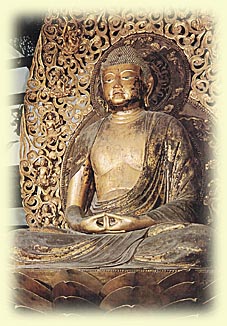|
THE WORLD OF YABUUCHI SatoshiEsculptor
|
||
|
||
|
When Japanese people think of Buddhist statuary they all share a common image. The words will conjure up the statue of a figure dressed in a thin robe, a round face with thin eyes, the head covered with spiral curls and an expression of perfect completion. The entire figure will have been covered in gold leaf when it was first made, although in many cases this will have worn off, exposing the shiny, black lacquer beneath. However, most people do not realize that this uniquely Japanese style was not developed until the eleventh century. It was the sculptor, Jocho, who perfected this style and with it a new method of creating wooden sculpture that is known as the Yosegi or joined-wood technique. Even today, sculptors of Buddhist figures still rely on the proportions and techniques that he developed in their work and it can be said that the "Jocho standard" has dictated the style of such work for one thousand years. I admire this great Buddhist sculptor for his skill both as an artist and as an organizer.
The amazing thing about Jocho is that not only did he create a new style of sculpture, he also developed a system of mass production that allowed large numbers of figures to be produced without any deterioration in quality. By setting the standard in this way, it meant that even statues made by other artists could all be described as being in the "Jocho style". The system he developed shares a lot in common with modern mass-production techniques and so Jocho could be described as being the Henry Ford of the Buddhist Sculpture. The Pure Land sect of Buddhism preaches that all people are capable of achieving Buddhahood through the simple repetition of the name of Amida (Amitabha), thus making it a very fair religion. It may have been the popularity of this sect that led people to want all the statues before which they prayed to look the same. This would explain the sudden appearance of a demand for identical statues, the like of which had never been seen before in the history of religion. In his book "Unkei" (published by Yoshikawa Kobunkan) the art historian SOEJIMA Hiromichi quotes an old work listing the number of Buddhist statues the Emperor Shirakawa had made during the course of his life. According to this, he ordered five statues of Buddhas ten meters tall (five if they were seated figures), six hundred and twenty-seven Buddhas five meters tall (two and a half if seated - the size of the Amida figure in the Byodoin Temple) and over six thousand Buddhas of less than human size. In the same book SOEJIMA also quotes from a document that states that Jocho produced twenty-seven life-size figures of Buddha in fifty-four days, using a staff of one hundred artists. This illustrates what a huge business there was to supply Buddhist statuary at this time as well as the boundless energy possessed by Jocho whose production far exceeding anything achieved by contemporary artists today. When people built temples to enshrine an image of Amida in preparation of their death, they would order a suitable statue from the sculptors in accordance to their wealth and position. In many ways this could be said to resemble the way in which contemporary people choose a car. Japanese cars are considered to be some of the best in the world, but in so far as their ability to transport people from one point to another is concerned, there is little difference between them. Therefore, people choose a small, medium or large, luxury car according to the amount they are prepared to pay. If they are only interested in getting to their destination, then a small car will suffice, but if they want a smooth ride, status and extra safety, they will buy a large luxury car. The manufacturers are well aware of this fact and provide products to suit everybody's needs and budget. In this respect, the statue of Amida in the Hoo-do (Phoenix Hall), of the Byodoin Temple at Uji, near Kyoto can be said to resemble a Rolls Royce that will take its donor to heaven in the height of luxury. Although the statues made by the Jocho method may vary in size and solemn splendor, by removing their individuality it can be said that they guaranteed people equal opportunity to enter paradise. Although statues made in the Jocho style can be seen throughout Japan, apart from the Amida in the Byodoin Temple there are very few that can definitely be said to have been made by Jocho himself. Of course many of his works were destroyed in fires during the wars that swept the country but considering his importance and the influence he was to have on future sculptors, it is very strange that more of his work does not exist. Jocho's style was inherited by the In and En schools which contained many talented sculptors but his system of proportion and production proved so efficient that those who came after him lost both the creativity and energy necessary to develop new styles. In the next period of history, the Kamakura period, Buddhist sculpture was to be taken over by the Kei school which built on the same techniques to experiment in other directions. Jocho worked at a time when Japan was cut off from the rest of the world, when the nobility extolled the glories of this world and culture was at a peak. He was a pre-eminent organizer and able to manifest his abilities to their fullest extent. Translated by Gavin Frew |
||
|
|
||
|
YABUUCHI Satoshi's Public Relations Dept.
UWAMUKI PROJECT webmaster@uwamuki.com All the text and images used on this site is copyrighted and its unauthorized use is strictly forbidden. |
